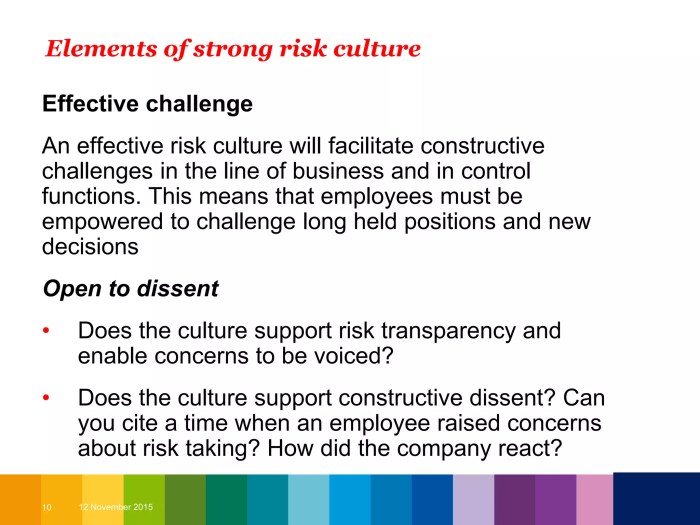
3 signs of a risk averse culture often manifest in organizational decision-making, communication, and employee behavior. Understanding these signs is crucial for organizations striving to foster a culture of calculated risk-taking. This post delves into the subtle yet impactful ways risk aversion can shape an organization, from how teams approach problems to the language used in meetings. We’ll explore the detrimental effects of a strong risk-averse culture and provide practical insights to help navigate this challenge.
This exploration of risk aversion will cover a range of factors, from the organizational structure to the subtle cues in communication. We’ll use real-world examples to illustrate these points, helping you identify risk-averse tendencies within your own organization. The ultimate goal is to help you understand how to spot risk aversion and, critically, how to foster a more balanced, productive environment that embraces calculated risk-taking.
Defining Risk Averse Culture
A risk-averse culture prioritizes avoiding potential losses and negative outcomes over pursuing potential gains. This approach permeates all aspects of decision-making, from strategic planning to daily operations. It’s a deeply ingrained value system that shapes how organizations approach challenges and opportunities.This culture is often characterized by a cautious, meticulous, and often slow approach to change and innovation. While this can lead to stability and predictability, it can also stifle creativity and adaptability in the face of rapid market shifts.
Understanding the nuances of a risk-averse culture is crucial for organizations aiming to navigate the complexities of today’s dynamic business environment.
Characteristics of a Risk-Averse Culture
A risk-averse culture manifests in several key characteristics. These characteristics, when present in tandem, paint a clear picture of an organization deeply committed to minimizing potential downsides. This commitment, however, may come at the expense of embracing bold, innovative approaches.
- Emphasis on meticulous planning and thorough analysis: Risk-averse organizations prioritize detailed plans, extensive research, and comprehensive analysis before undertaking any significant action. They favor well-defined procedures and guidelines to ensure that every step aligns with established protocols. This methodical approach is evident in their budgeting processes, project management methodologies, and operational strategies.
- Preference for incremental change over radical transformations: These organizations often favor gradual, incremental improvements over radical shifts or disruptive innovations. The cautious approach prioritizes maintaining stability and avoiding significant disruptions. The focus is often on refining existing processes and procedures rather than adopting entirely new approaches.
- Strong emphasis on adherence to rules and regulations: A risk-averse culture is deeply rooted in compliance. Strict adherence to rules, regulations, and internal policies is paramount. Deviation from established protocols is discouraged, even in situations where a more flexible approach might be beneficial.
Examples of Organizations with a Risk-Averse Culture
Several types of organizations exhibit a strong risk-averse culture. The nature of their work often dictates this cautious approach, which can be either a strength or a weakness, depending on the context.
Three signs of a risk-averse culture often manifest in a reluctance to explore new avenues. Employees might avoid taking calculated risks, preferring the familiar and predictable. This is particularly relevant in today’s rapidly evolving job market, where LinkedIn’s recent update allowing users to cast wider search nets for potential opportunities ( linkedin lets users cast wider search net ) can be seen as a direct response to this tendency.
Ultimately, a lack of innovation and a hesitation to step outside the box are strong indicators of a risk-averse culture.
- Government agencies: Government agencies, by their nature, are often highly risk-averse. The potential consequences of mistakes can be substantial, affecting public safety and resources. Consequently, they prioritize meticulous planning, thorough vetting of proposals, and adherence to strict procedures. This is evident in their procurement processes and regulatory frameworks.
- Utilities and infrastructure companies: Companies managing crucial infrastructure, such as utilities or transportation networks, must operate with a high degree of reliability and stability. The consequences of errors can be catastrophic. They typically adopt a risk-averse approach to minimize the chance of disruptions or accidents. This manifests in their rigorous maintenance schedules, safety protocols, and disaster preparedness plans.
Comparing Risk-Averse and Calculated Risk-Taking Cultures
Risk-averse cultures stand in contrast to cultures that embrace calculated risk-taking. The latter prioritize calculated risks that offer the potential for significant rewards, even if there is a chance of failure.
- Risk-averse cultures prioritize stability and avoidance of losses. They are characterized by thorough planning, adherence to regulations, and incremental change. This approach can lead to predictable outcomes but may stifle innovation and adaptability.
- Calculated risk-taking cultures are driven by the potential for high rewards. They are more open to experimentation and innovation, even if there is a chance of failure. This approach can lead to faster growth and more significant breakthroughs, but also to higher levels of risk.
Framework for Identifying Key Characteristics of a Risk-Averse Culture
A comprehensive framework can help identify the key characteristics of a risk-averse culture within an organization. This framework provides a structured approach for analyzing the organization’s practices and decision-making processes.
Three signs of a risk-averse culture often manifest in a reluctance to innovate. For instance, companies might avoid pushing the boundaries of technology, like how HP is now offering more powerful mini PCs with advanced hardware and software configurations in their latest models. hp packs mini pcs with more hardware software This could stem from a fear of failure or a desire for predictable results, ultimately hindering progress.
These characteristics frequently appear in a company’s reluctance to take calculated risks, preferring instead to stick with the familiar.
| Characteristic | Description | Example | Impact on Business Decisions |
|---|---|---|---|
| Emphasis on Planning | Detailed plans, extensive research, and thorough analysis before action. | Extensive market research before launching a new product. | Can lead to well-informed but potentially slow decision-making. |
| Adherence to Rules | Strict compliance with regulations and internal policies. | Rigorous adherence to safety protocols in manufacturing. | Ensures consistency and minimizes legal risks but might hinder flexibility. |
| Incremental Change | Gradual improvements over radical transformations. | Implementing small, incremental process improvements over a period. | Maintains stability but may slow down progress in response to rapid market changes. |
| Focus on Avoiding Losses | Prioritizing minimizing potential losses over maximizing gains. | Choosing a conservative investment strategy. | Preserves capital but might miss out on higher potential returns. |
Signs of Risk Aversion in Decision-Making
A risk-averse culture often manifests itself most prominently in the decision-making process. Individuals and teams within such a culture prioritize avoiding potential negative outcomes over pursuing potentially rewarding opportunities. This cautious approach, while seemingly prudent, can stifle innovation and progress if not carefully managed. Understanding the specific indicators of risk aversion in decision-making is crucial for fostering a more adaptable and dynamic organizational environment.
Indicators of Risk Aversion in Meetings
Decision-making processes within risk-averse organizations frequently exhibit a consistent pattern of caution. This translates to meetings characterized by extensive debate, detailed scrutiny of every potential downside, and a reluctance to embrace novel ideas. The emphasis is often on meticulous planning, thorough analysis, and minimizing any uncertainty. This approach can lead to delays and missed opportunities.
Detailed Analysis of Decision-Making Indicators
This meticulous approach to decision-making often manifests in several key indicators. These indicators can be observed in the discussions and interactions within meetings.
| Indicator | Explanation | Example | Potential Negative Impact |
|---|---|---|---|
| Overemphasis on Potential Losses | Decisions are primarily driven by fear of failure, rather than the potential for gain. Concerns about negative outcomes are magnified, while potential benefits are often downplayed. | A team discussing a new marketing campaign spends disproportionate time and energy on worst-case scenarios of low engagement or negative press, while the potential for increased market share is given less weight. | Missed opportunities for growth and innovation; decreased agility in responding to market changes. |
| Extensive Precautionary Measures | Decisions are surrounded by an abundance of safeguards and backup plans. This often leads to increased complexity and cost. | A project team creates elaborate contingency plans for every possible obstacle, resulting in a highly complex and costly project timeline. | Increased project costs and delays; reduced efficiency and flexibility in responding to unexpected challenges. |
| Consensus Seeking at the Expense of Speed | The need for unanimous agreement and avoidance of conflict often delays decisions, even when a clear path forward is apparent. | A team debates a proposal for weeks, seeking every member’s agreement, even on minor points. This prevents a timely implementation of a potentially valuable project. | Slow decision-making process; missed deadlines; reduced responsiveness to market needs. |
Risk Aversion in Communication and Policy
A risk-averse culture isn’t just about avoiding calculated dangers; it profoundly shapes how teams communicate and create policies. This often manifests in cautious language, a preference for detailed procedures, and a reluctance to deviate from established norms. Understanding this aspect is crucial for fostering a more dynamic and innovative work environment.Risk-averse communication styles frequently prioritize clarity and predictability over spontaneity and experimentation.
This can result in a lack of emotional expression and a cautious approach to sharing ideas. Policies in such environments are often rigid, aiming to minimize the likelihood of unforeseen consequences. These practices, while potentially protecting the organization from significant losses, can also stifle creativity and innovation.
Communication Styles Reflecting Risk Aversion
Communication in a risk-averse culture tends to be formal, cautious, and focused on minimizing ambiguity. Direct, unambiguous language is preferred, often avoiding strong opinions or emotional expression. This preference for precision can lead to lengthy explanations and a reluctance to take risks in expressing potentially controversial ideas. The focus is often on the potential negative consequences of any action, rather than the potential benefits.
Examples of Risk-Averse Policies
Risk-averse policies frequently emphasize strict adherence to established procedures and protocols. These policies often detail every step of a process, leaving little room for individual interpretation or deviation. Extensive documentation is typically required, and deviations from standard operating procedures necessitate approvals from multiple levels of management. Such policies, while ensuring consistency and minimizing errors, can slow down decision-making and limit agility.
Impact of Risk-Averse Communication on Innovation and Creativity
Risk-averse communication can significantly hinder innovation and creativity. The fear of expressing unconventional ideas or challenging established norms can discourage employees from taking calculated risks. This can lead to a stagnation of new ideas and a lack of adaptability in response to changing market conditions. The emphasis on avoiding mistakes may inadvertently discourage employees from experimenting with new approaches, thereby stifling creative problem-solving.
Common Phrases Used in Risk-Averse Communication, 3 signs of a risk averse culture
Risk-averse communication frequently employs phrases that emphasize caution, certainty, and adherence to established procedures. These phrases often prioritize avoiding mistakes over embracing new opportunities.
“Let’s proceed cautiously.””We need to ensure all bases are covered.””We’ve always done it this way.””Let’s not take any unnecessary risks.””We should avoid anything that could be interpreted as controversial.”
Table: Communication Style, Description, Example, Impact on Innovation
| Communication Style | Description | Example | Impact on Innovation |
|---|---|---|---|
| Formal | Using professional and structured language, avoiding slang or informal expressions. | “In order to achieve optimal results, we must adhere to the Artikeld protocol.” | Can create a sense of distance and discourage spontaneous idea sharing. |
| Precise | Focusing on clear and detailed explanations, minimizing ambiguity. | “The next step involves meticulously documenting all findings before proceeding.” | May lead to over-planning and delay the implementation of new ideas. |
| Cautious | Avoiding strong opinions or emotional expression, emphasizing potential downsides. | “While this approach shows promise, we must carefully consider the potential pitfalls.” | Can discourage employees from taking risks with innovative solutions. |
| Prescriptive | Detailing every step of a process, leaving little room for deviation. | “The process for submitting expense reports requires meticulous adherence to form and procedure.” | Limits flexibility and adaptability, hindering innovation and experimentation. |
Risk Aversion in Employee Behavior

Risk aversion isn’t just a trait in decision-making; it deeply impacts employee behavior, often shaping the entire team dynamic. Understanding how risk-averse employees operate is crucial for fostering a productive and positive work environment. Recognizing their tendencies allows managers to better support them, encourage calculated risk-taking, and leverage their strengths within the team.Risk-averse employees often prioritize stability and predictability in their work.
Three telltale signs of a risk-averse culture often manifest in hesitation and a preference for the familiar. Think about how a company might favor tried-and-true solutions, like the trusty netbook, over the more innovative, but potentially risky, Chromebook. The article “chromebook big brother to netbook distant 3rd cousin to tablet” here explores the evolution of computing devices, highlighting this preference for the known.
This cautious approach, while sometimes preserving stability, can also stifle progress and limit growth, ultimately hindering innovation. Ultimately, a risk-averse culture often avoids novel solutions, preferring proven methods instead.
This tendency can manifest in various ways, impacting the overall team’s ability to adapt and innovate. Their cautious approach can sometimes hinder progress and limit the team’s potential for growth, but their meticulousness can also be a valuable asset. Finding the right balance between encouraging calculated risk-taking and supporting the needs of risk-averse employees is key.
Typical Behaviors of Risk-Averse Employees
Risk-averse employees generally exhibit a preference for familiar tasks and established processes. They tend to avoid tasks with ambiguous outcomes or uncertain results. This often translates into a strong desire to follow procedures precisely, meticulously document every step, and seek explicit instructions before acting. They are typically comfortable in clearly defined roles and responsibilities.
Impact on Team Dynamics
The prevalence of risk-averse employees within a team can significantly impact its dynamics. While their meticulousness can lead to higher accuracy and fewer errors, it can also stifle creativity and innovation. A team dominated by risk-averse individuals might struggle to embrace new ideas or take calculated risks, potentially hindering the team’s overall performance. The fear of failure can create a climate of hesitancy, where individuals are more concerned with avoiding mistakes than taking advantage of opportunities.
Examples of Impact on Productivity and Morale
Risk-averse employees might delay decision-making, leading to project delays. They might also be reluctant to take ownership of tasks that require independent judgment, impacting overall productivity. This hesitancy can affect morale, as team members who are comfortable with calculated risks may feel undervalued or frustrated by the slower pace. The constant need for approval and explicit guidance can also create a feeling of micromanagement, further impacting morale and job satisfaction.
Comparison: Handling Challenges
Risk-averse employees, when faced with challenges, often analyze potential pitfalls meticulously. They might spend considerable time researching solutions and consulting with others before taking any action. This approach can lead to thorough and well-considered decisions, but it can also result in slower response times, hindering the team’s ability to adapt to sudden changes or unexpected circumstances.Conversely, employees comfortable with calculated risk often see challenges as opportunities for growth and innovation.
They’re more likely to experiment with new approaches, even if it means taking some calculated risks. This proactive approach can lead to faster responses and more creative solutions, but it also carries the risk of mistakes. The key is to find a balance between calculated risk-taking and meticulous planning.
Employee Behavior in Handling Challenges
| Employee Behavior | Description | Example | Impact on Team Dynamics |
|---|---|---|---|
| Risk-Averse | Detailed analysis of potential pitfalls; seeking multiple opinions; extensive research before acting. | A marketing team member, facing a new social media campaign, spends weeks researching competitors’ strategies and consulting with colleagues before launching any posts. | Slower response time, potentially missed opportunities for quick wins. |
| Calculated Risk-Taker | Experimentation with new approaches; taking calculated risks; proactively seeking solutions. | A software engineer, encountering a bug in a new feature, quickly tries several debugging methods before escalating to senior colleagues. | Faster responses, potentially more innovative solutions, but also higher risk of errors. |
Risk Aversion and Organizational Structure: 3 Signs Of A Risk Averse Culture

Organizational structure plays a crucial role in shaping a company’s risk appetite. It dictates the flow of information, decision-making processes, and ultimately, the tolerance for calculated risks. A rigid structure often leads to a risk-averse culture, while a flatter, more agile structure can foster a more calculated approach to risk-taking. Understanding the interplay between organizational design and risk tolerance is vital for creating a dynamic and successful enterprise.Hierarchical structures, characterized by multiple layers of management and a clear chain of command, frequently foster risk aversion.
Hierarchical Structures and Risk Aversion
Hierarchical structures, with their well-defined reporting lines and established protocols, can inadvertently create a culture of risk aversion. Decisions often get filtered through multiple layers, leading to slower responses and a greater emphasis on avoiding potential mistakes. This can result in missed opportunities and a general reluctance to take calculated risks.
Examples of Hierarchical Structures that Encourage Risk Aversion
- A company with a highly centralized decision-making process, where all major decisions must be approved by senior management, often creates a culture of risk aversion. This process can slow down the response time to market changes and limit the ability to adapt quickly to new opportunities.
- Bureaucratic organizations, characterized by numerous rules and regulations, typically have a risk-averse culture. The fear of violating established procedures discourages experimentation and innovation, leading to a slower pace of development and potentially missed opportunities for growth.
- Traditional military organizations, with their strict chain of command and emphasis on adherence to established protocols, provide a classic example of a risk-averse culture. The focus on following orders and avoiding mistakes often results in a reluctance to deviate from the established procedures, even when it may be advantageous to do so.
Flatter Structures and Calculated Risk-Taking
Flatter organizational structures, with fewer management layers and more decentralized decision-making, often encourage calculated risk-taking. Employees at all levels are empowered to make decisions, fostering a culture of agility and responsiveness. This empowerment can lead to faster adaptation to market changes and the identification of new opportunities.
Rigid Procedures and Risk Aversion
Rigid procedures and policies can create a strong culture of risk aversion. These procedures, designed to prevent errors, can inadvertently stifle innovation and creativity. Employees might hesitate to deviate from established processes, even when it could lead to better outcomes. This is particularly true in industries where safety and compliance are paramount.
Impact of Organizational Structure on Risk Tolerance
| Organizational Structure | Description | Example | Impact on Risk Tolerance |
|---|---|---|---|
| Hierarchical | Multiple layers of management, centralized decision-making. | A large multinational corporation with a complex reporting structure. | Low risk tolerance; decisions slow, emphasis on avoiding mistakes. |
| Flat | Few management layers, decentralized decision-making. | A startup company with a small team and a flat structure. | Higher risk tolerance; faster decision-making, adaptability. |
| Matrix | Combines functional and project-based structures. | A company with product teams and cross-functional departments. | Moderate risk tolerance; balance between departmental and project needs. |
| Network | Decentralized, interconnected teams or individuals. | A freelance design firm with independent contractors. | High risk tolerance; flexibility and agility but potentially with less control. |
Illustrative Case Studies
Understanding risk-averse cultures requires more than just theory. Real-world examples provide crucial insights into how these cultures manifest and the consequences they bring. Examining specific cases illuminates the interplay between factors like organizational structure, communication styles, and decision-making processes. These case studies highlight the impact of a strong aversion to risk, showing both the potential benefits and drawbacks of such a culture.
Case Study 1: The Bureaucratic Bank
This bank, known for its meticulous procedures and stringent regulations, operates within a highly risk-averse environment. Every loan application, every investment decision, and every internal communication is scrutinized extensively. This meticulous approach is driven by a fear of any potential losses. A core value is the protection of existing assets, even if it means slower growth and missed opportunities.
Key Factors contributing to the risk-averse culture include a legacy of financial crises, a hierarchical structure emphasizing compliance over innovation, and a strong emphasis on maintaining a stable reputation.
Consequences of this approach include slow decision-making, missed opportunities for new product development, and a slower response to market changes. While the bank maintains a strong financial position, its competitors with more flexible approaches often outpace it in terms of growth and innovation.
Case Study 2: The Pharmaceutical Giant
This pharmaceutical company, renowned for its rigorous clinical trials and stringent regulatory compliance, operates within a highly risk-averse environment. The focus is on minimizing the chance of adverse effects or legal challenges, leading to an extensive review process for new drug development. This meticulous approach is driven by the need to ensure the safety and efficacy of their products.
Key Factors include a history of product recalls, intense regulatory scrutiny in the pharmaceutical industry, and a strong emphasis on long-term safety. This culture also values the reputation of the company and its commitment to public health.
Consequences of this approach include a longer time to market for new drugs, potentially leading to delayed treatment options for patients and a slower response to emerging health threats. While the company maintains a high level of product safety, competitors with more flexible approaches may gain market share by introducing new therapies more quickly.
Case Study 3: The Government Agency
This government agency, tasked with managing public funds, operates within a highly risk-averse environment. Every expenditure must be meticulously justified and documented to avoid accusations of mismanagement or fraud. This stringent approach is driven by a desire to uphold public trust and avoid political backlash.
Key Factors contributing to the risk-averse culture include public scrutiny of government spending, a history of financial scandals, and the need to maintain public trust. This culture values transparency and accountability above all else.
Consequences of this approach include a bureaucratic process for funding requests, slow disbursement of funds, and a possible delay in addressing critical needs. While the agency maintains a strong reputation for fiscal responsibility, it may be less agile in responding to emergent crises or societal needs.
| Case Study | Key Factors | Consequences |
|---|---|---|
| The Bureaucratic Bank | Legacy of crises, hierarchical structure, stable reputation | Slow decision-making, missed opportunities, slower response to market changes |
| The Pharmaceutical Giant | Product recalls, regulatory scrutiny, long-term safety | Longer time to market, delayed treatment options, slower response to emerging threats |
| The Government Agency | Public scrutiny, financial scandals, public trust | Bureaucratic process, slow disbursement, less agility |
Wrap-Up
In conclusion, recognizing the three signs of a risk-averse culture—in decision-making, communication, and employee behavior—is vital for fostering a more dynamic and innovative work environment. By understanding the impact of these signs, organizations can proactively address potential downsides and cultivate a culture that embraces calculated risk-taking. Ultimately, this will lead to more agile decision-making, improved employee morale, and a more successful organization.





